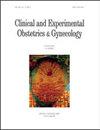宫颈长度不确定病例的子宫宫颈前角和早产预测:一项前瞻性队列先导研究
IF 0.6
4区 医学
Q4 OBSTETRICS & GYNECOLOGY
引用次数: 0
摘要
背景:宫颈长度测量仍然是预测早产最广泛使用的方法。最近的研究报道,除了宫颈长度,子宫宫颈角(UCA)也可用于预测早产。本研究的主要目的是评估宫颈长度为20 - 30mm的有症状孕妇使用前UCA预测早产的效果。方法:在这项前瞻性队列研究中,将2019年9月至2020年2月期间在急诊科就诊的48例宫颈长度为20 ~ 30 mm且有任何早产症状的患者作为研究组。首次入院时测量颈椎长度和前路UCA。在这48名患者中,12名在37周前分娩的患者被称为“早产组”,36名在37周或更晚分娩的患者被称为“有早产危险但足月分娩”组。对照组由46名健康孕妇组成,她们在年龄、体重指数(BMI)和妊娠周数方面与研究组相匹配。比较三组的前路UCA值。结果:“早产”组和“先兆早产但足月分娩”组宫颈长度与对照组相似,且短于对照组(分别为25.4 mm、25.1 mm和35 mm);0.001)。“早产”组的前路UCA值(116.1)明显高于“有早产威胁但足月分娩”组(100.2)和对照组(98.6)(p = 0.001)。采用受试者工作曲线(ROC)分析确定前路UCA的阈值,该阈值可预测宫颈长度为20 ~ 30 mm的有症状孕妇的早产。前路UCA曲线下面积(AUC)分析对早产的估计为0.647 (p = 0.014, 95%可信区间(CI) = 0.52-0.77)。根据本分析,确定前路UCA的阈值为95.3,敏感性为72%,特异性为63%。结论:宫颈长度为20 ~ 30mm且无宫颈膨出和宫颈扩张的有症状孕妇,前路UCA能较好地预测早产。本文章由计算机程序翻译,如有差异,请以英文原文为准。
Anterior Uterocervical Angle and Prediction of Preterm Labor in Cases with an Inconclusive Cervical Length: A Prospective Cohort Pilot Study
Background: Cervical length measurement is still the most widely used method to predict preterm labor. Recent studies have reported that in addition to cervical length, uterocervical angle (UCA) may also be useful in predicting preterm labor. The main purpose of this study was to evaluate the use of the anterior UCA to predict preterm labor in symptomatic pregnant women with a cervical length of 20 to 30 mm. Methods: In this prospective cohort study, 48 patients with a cervical length of 20 to 30 mm who applied to the emergency department with any preterm labor symptoms, between September 2019 and February 2020, were included as the study group. Cervical length and anterior UCA were measured at the first admission. Of these 48 patients, 12 patients who gave birth before 37 weeks were called the ‘preterm labor group’, and 36 patients who gave birth at 37 weeks or later were named the ‘preterm threatened but delivered at term’ group. The control group consisted of 46 healthy pregnant women who were matched with the study group in terms of age, body mass index (BMI), and the gestational week at which anterior UCA was measured. The three groups were compared in terms of anterior UCA values. Results: The cervical lengths of the ‘preterm labor’ and ‘preterm threatened but delivery at term’ groups were similar and shorter than the control group (25.4 mm, 25.1 mm, and 35 mm, respectively, p < 0.001). Anterior UCA value in the ‘preterm labor’ group (116.1) was found to be significantly higher than both ‘preterm threatened but delivered at the term’ group (100.2) and the control group (98.6) (p = 0.001). Receiver operating curve (ROC) analysis was performed to determine a threshold value of anterior UCA that could predict preterm labor in symptomatic pregnant women with a cervical length of 20 to 30 mm. Area under curve (AUC) analysis of anterior UCA for estimation of preterm labor was 0.647 (p = 0.014, 95% confidence interval (CI) = 0.52–0.77). According to this analysis, the threshold value of anterior UCA was determined as 95.3, with 72% sensitivity, and 63% specificity. Conclusion: The anterior UCA can be used to better predict preterm labor in symptomatic pregnant women with a cervical length of 20 to 30 mm without cervical effacement and dilation.
求助全文
通过发布文献求助,成功后即可免费获取论文全文。
去求助
来源期刊
CiteScore
0.50
自引率
0.00%
发文量
241
审稿时长
1 months
期刊介绍:
CEOG is an international, peer-reviewed, open access journal. CEOG covers all aspects of Obstetrics and Gynecology, including obstetrics, prenatal diagnosis, maternal-fetal medicine, perinatology, general gynecology, gynecologic oncology, uro-gynecology, reproductive medicine, infertility, reproductive endocrinology, sexual medicine. All submissions of cutting-edge advances of medical research in the area of women''s health worldwide are encouraged.

 求助内容:
求助内容: 应助结果提醒方式:
应助结果提醒方式:


